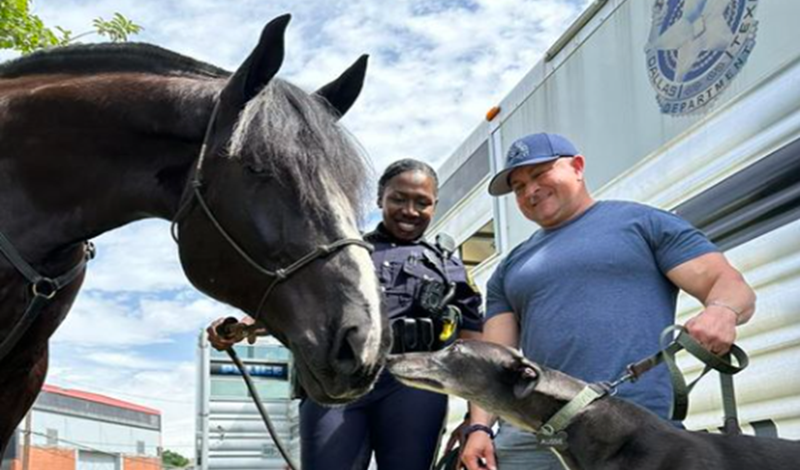
The perpetuation of police therapy animals is a gift that keeps on giving at a time when cops need it more than ever before. With chaos spread like wildfire across the nation, police psyches are overstacked with stress that can be mitigated by contact with animals.
Given the topsy-turvy world we are experiencing, with law enforcement officers feverishly pushing back on the tidal wave of malice unleashed by violent individuals, the splendor unconditionally offered by service animals of varying species is a gift wrapped in fur.
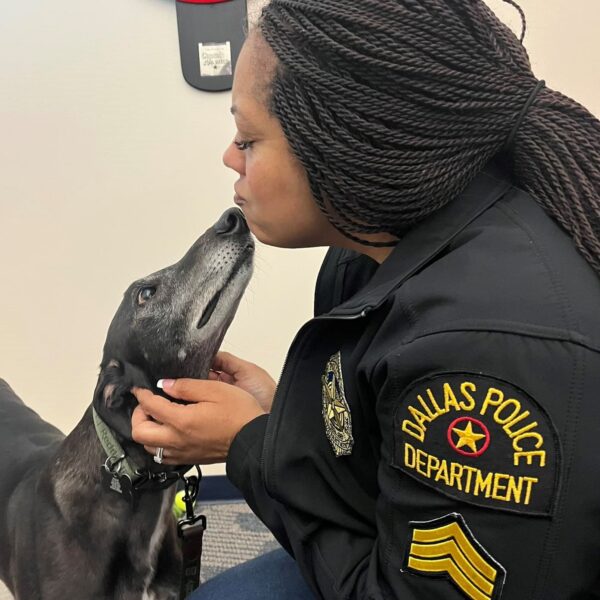
(Photo courtesy of Assisting the Officer, Bridging the Divide.)
It is so blatantly obvious how chronically cops are pushed to the brink, increasing the pressures of police work and mounting the stress from ongoing anarchy. Police officer wellness is garnering more attention, with good reason.
More law enforcement agencies are adding therapy animals to their ranks, aiding both sworn and non-sworn staff by being present, in an unconditional manner, and transporting challenged psyches to a harmonious togetherness that counters the litany of depraved indifference confronted out on the street beat.
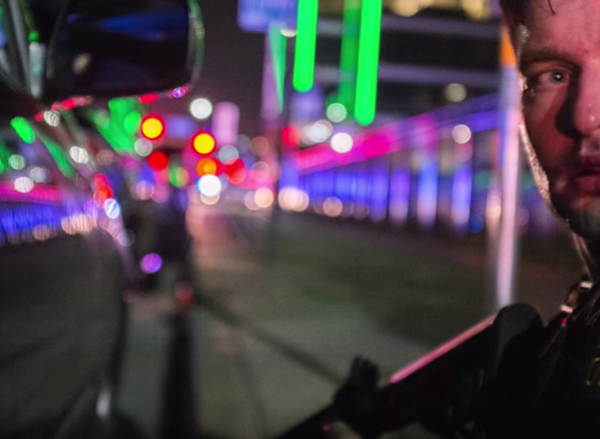
A Christian radio station I was listening to the other day discussed a recently published study that underscored the huge benefits for those who suffered a traumatic brain injury (TBI) event (such as any service members in our military branches) and cops who endure the ongoing battle with PTSD derived from witnessing a litany of horrific scenes laden with depraved indifference.
Not pretending to be a psychoanalyst or clinician, I can nonetheless imagine the experience between animals and humans is catalyzed by the tactile aspect, with law enforcement officers mentally and/or physically burdened by indelible experiences from a tremendously stressful role.
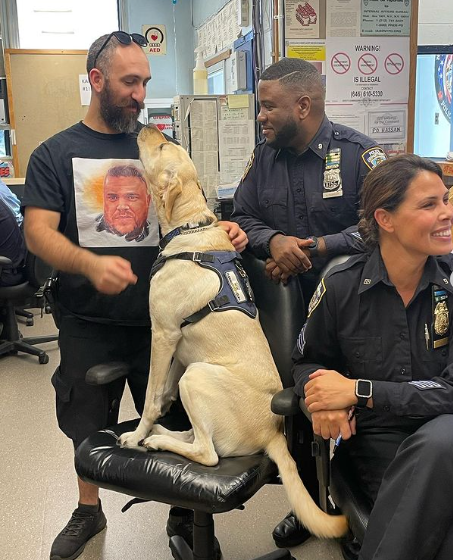
(Photo courtesy of Det. Piper NYPD.)
Finding simple solace by petting strands of fur while hearing the recipient animal’s appreciation and mutual enjoyment of the interaction is one chalked into the Befriend column—a symbiosis of sorts.
Philosophers and stoics tell us that quality orientations between different species interacting silently can easily reach the brim of solitude and sanctity. I nod to that…
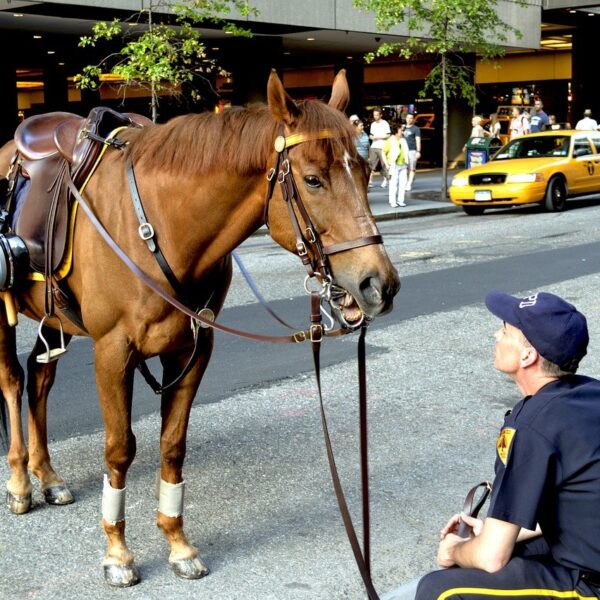
(Photo courtesy of Chanh Nguyen via Pixabay.)
Taking it further, I never even considered police service animals being there for each other, partners in the mission to offer sensory attributes to police officers, sheriff’s deputies, state troopers, and constables. (Respectfully, I figure conservation officers have had the occupational luxury of what we are discussing today.)
Hence, a recent Dallas Police Department Tactical Support Division post (illustrated up top) captivated my attention and compelled me to ponder the de-stressing capabilities of police service animals, whether deemed for therapy or physical patrol functions…
“This was the highlight of my day. ‘Hawk’ got the opportunity to meet Dallas PD therapy dog ‘Aussie.’ They connected once Aussie realized Hawk was a gentle giant! Thank you, [Officer] J. King for the introduction,” wrote a Dallas PD officer assigned to the agency’s Tactical Support Division.
Per Dallas Police Officer King, “Aussie had never seen an animal that large. It was really cute. His tail was wagging the entire time.”
Animal-Assisted Therapy
As defined in the pages of Psychology Today, “Animal-assisted therapy is a therapeutic intervention that incorporates animals, such as horses, dogs, cats, and birds,” with applications to help overcome “stress, anxiety, depression, autism, ADHD, addiction, schizophrenia, emotional and behavioral problems, Alzheimer’s disease, and some medical conditions.”
By the nature of their work, cops are subject to many of these things, compounded by the craziness in contemporary society.
Per the Texas Municipal Police Association (TMPA), Statistics show that in America, one officer is shot every 22 hours, underscoring the ongoing War on Cops.” That came up while I was writing this material; TMPA reported on yet another cop shot in the line of duty, this time in Corpus Christi, a few hours ago.
Researching the manifold benefits of animals in the lives of humans, I landed on an article published by Psychology Today, expounding on a New York Times piece that covered the TBI sustained by a world-class cyclist who crashed her bike while competing. It changed her world. It forever altered her mindset. It hijacked her. Finding it unbearable, she took her life.
Experiencing constant dire straits in an occupational capacity, cops tragically succumb to The Job’s toll and take their lives despite the growing resources offered to overcome the gruesomeness of police duty and salvage souls.
Copline is one such source, comprised of law enforcement professionals answering 1-800-COPLINE, “a 24-hour confidential hotline for law enforcement officers to reach out for help.”
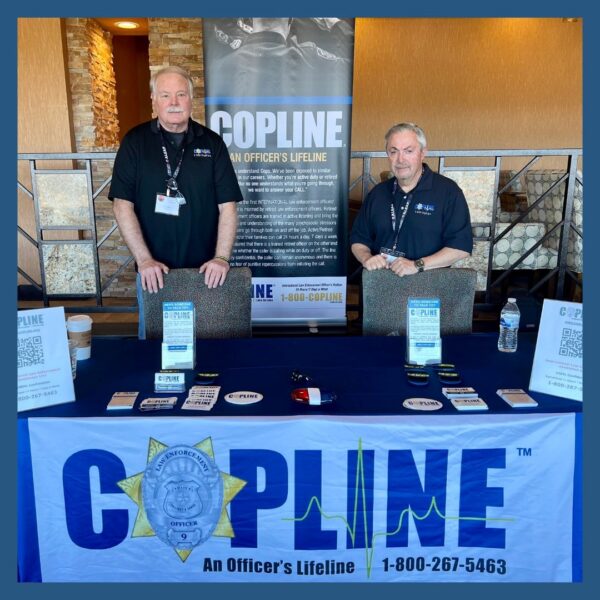
(Photo courtesy of COPLINE.)
Perhaps the cyclist battled the demons many law enforcement officers contend with, their cranium comprised of a metaphoric boxing ring in which to bob and weave, duck and swing, hoping to hear the bell and garner some respite (like COPLINE, or police-based help groups just like it…or service animals).
In the Psychology Today article, the author delves into animal-assisted therapy and how equally curious furry creatures deliver the right brand of respite ideally suited for America’s first responders, those who don justice garb and have looping scenes of tragedies flicking across their minds.
Representing and reporting all things police, the National Police Association (NPA) published material about the Dallas Police Department’s OWL unit —Officer Wellness Longevity— incorporating a greyhound named “Aussie” who mingles and produces smiles on the faces of all police personnel…and others he meets, such as police horse Hawk.
Aussie epitomizes the purpose of police therapy dogs among law enforcement professionals who need to decompress at every turn: “Hey, y’all, I’m a retired athlete here to help first responders with PTSD. I’m assigned to Dallas Police Wellness unit.”
Similarly, the St. Tammany Parish Sheriff’s Office (STPSO) is making rounds with their new therapy dog “Luna” (recently showcased on the NPA Report) spending quality time with their agency’s personnel and community members.
Partnered with Deputy C.W. Lemoine, Luna also makes rounds in the community, visiting school-age children and other citizens’ groups.
Both Deputy Lemoine and Luna traverse the region in an STPSO fully marked SUV cruiser bearing the graphic imagery of Luna and the words “Therapy K9,” so that the public readily recognizes this cop car does not necessarily contain the other brand of service animal that is trained to track bad guys and bring them down when repeated commands are resistant and custody is paramount.
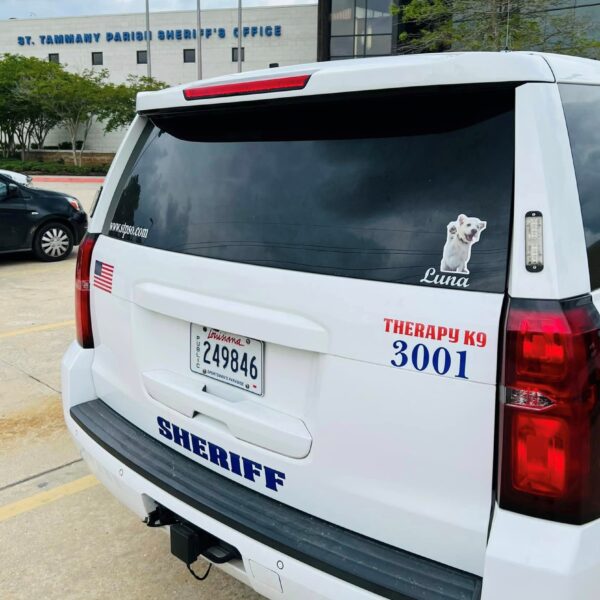
(Photo courtesy of the St. Tammany Parish Sheriff’s Office.)
Increasingly, America’s law enforcement agencies are adding police therapy animals to/for their ranks.
“A picture paints a thousand words” is an adage we often read/hear throughout life. As such, last night was one such episode, underscoring today’s topic, illustrated by a caravan of NYPD police sergeants exhibiting the tell-tale sign of having been given marching orders…
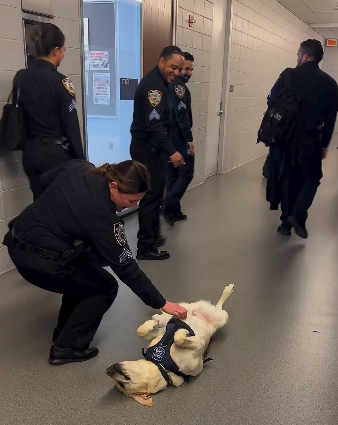
(Photo courtesy of Det. Piper NYPD.)
Before hitting the streets, though, these men and women in blue, wearing stripes signaling responsibilities to oversee many other men and women in blue, partake in a passing moment to engage with the NYPD’s Piper the Therapy Dog, taking care of police business.
Although I wasn’t digging for it, I found another bone: Two NYPD therapy dogs (one of whom is Piper) assigned to bring equilibrium to police officers working the most recent St. Patrick’s Day Parade in New York City, its throngs of attendees heightening the conventional alertness of cops working a metropolis beat amid a climate of ongoing chaos and targeting of LEOs.
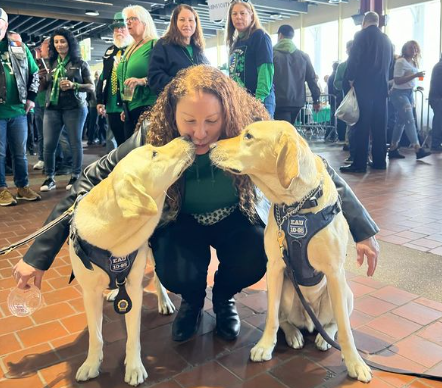
(Photo courtesy of Det. Piper NYPD.)
Well, would you look at that: Another nose-to-nose involving police service animals working in wellness for all, especially cops.